Page 99 of 240
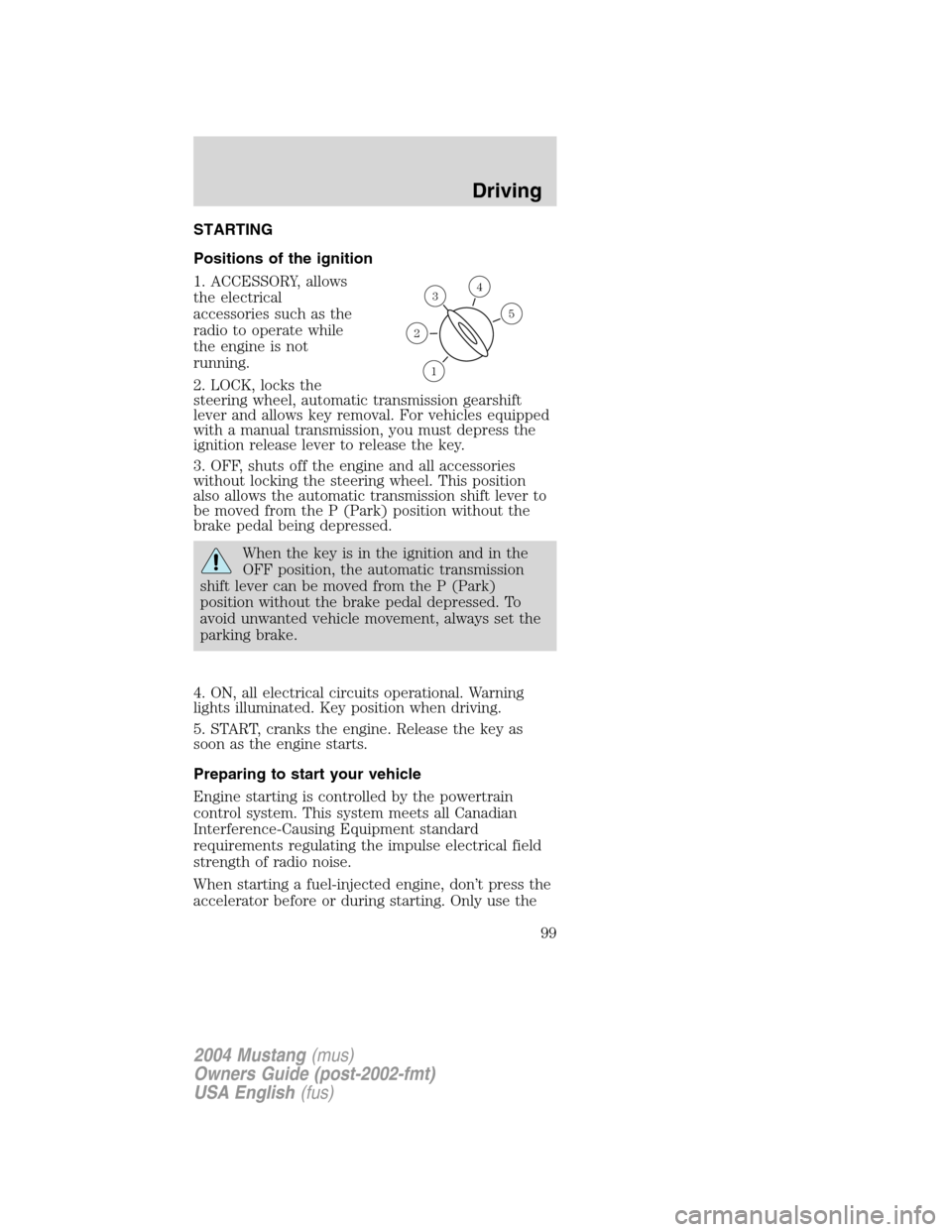
STARTING
Positions of the ignition
1. ACCESSORY, allows
the electrical
accessories such as the
radio to operate while
the engine is not
running.
2. LOCK, locks the
steering wheel, automatic transmission gearshift
lever and allows key removal. For vehicles equipped
with a manual transmission, you must depress the
ignition release lever to release the key.
3. OFF, shuts off the engine and all accessories
without locking the steering wheel. This position
also allows the automatic transmission shift lever to
be moved from the P (Park) position without the
brake pedal being depressed.
When the key is in the ignition and in the
OFF position, the automatic transmission
shift lever can be moved from the P (Park)
position without the brake pedal depressed. To
avoid unwanted vehicle movement, always set the
parking brake.
4. ON, all electrical circuits operational. Warning
lights illuminated. Key position when driving.
5. START, cranks the engine. Release the key as
soon as the engine starts.
Preparing to start your vehicle
Engine starting is controlled by the powertrain
control system. This system meets all Canadian
Interference-Causing Equipment standard
requirements regulating the impulse electrical field
strength of radio noise.
When starting a fuel-injected engine, don’t press the
accelerator before or during starting. Only use the
3
1
2
5
4
2004 Mustang(mus)
Owners Guide (post-2002-fmt)
USA English(fus)
Driving
99
Page 102 of 240
•Turn the key to 4
(ON) without
turning the key to 5
(START).
Make sure the corresponding lights illuminate or
illuminate briefly. If a light fails to illuminate, have
the vehicle serviced.
•If the driver’s safety belt is fastened, the
light
may not illuminate.
1
2
34
5
P! BRAKE
L
0
00000 00
C
E
FH
LH
10 203020 406080100
120
140
160
180
405060 70
80
90
100
11 0
1204
5
6
7 3
2
1
H
THEFT
RPMX1000
FUEL DOORSELECT/RESET
LOW
FUELO/D
OFF AIR
BAGSERVICE
ENGINE
SOON
MPH km/h
ABS
.
CHECK
FUEL
CAP
2004 Mustang(mus)
Owners Guide (post-2002-fmt)
USA English(fus)
Driving
102
Page 104 of 240
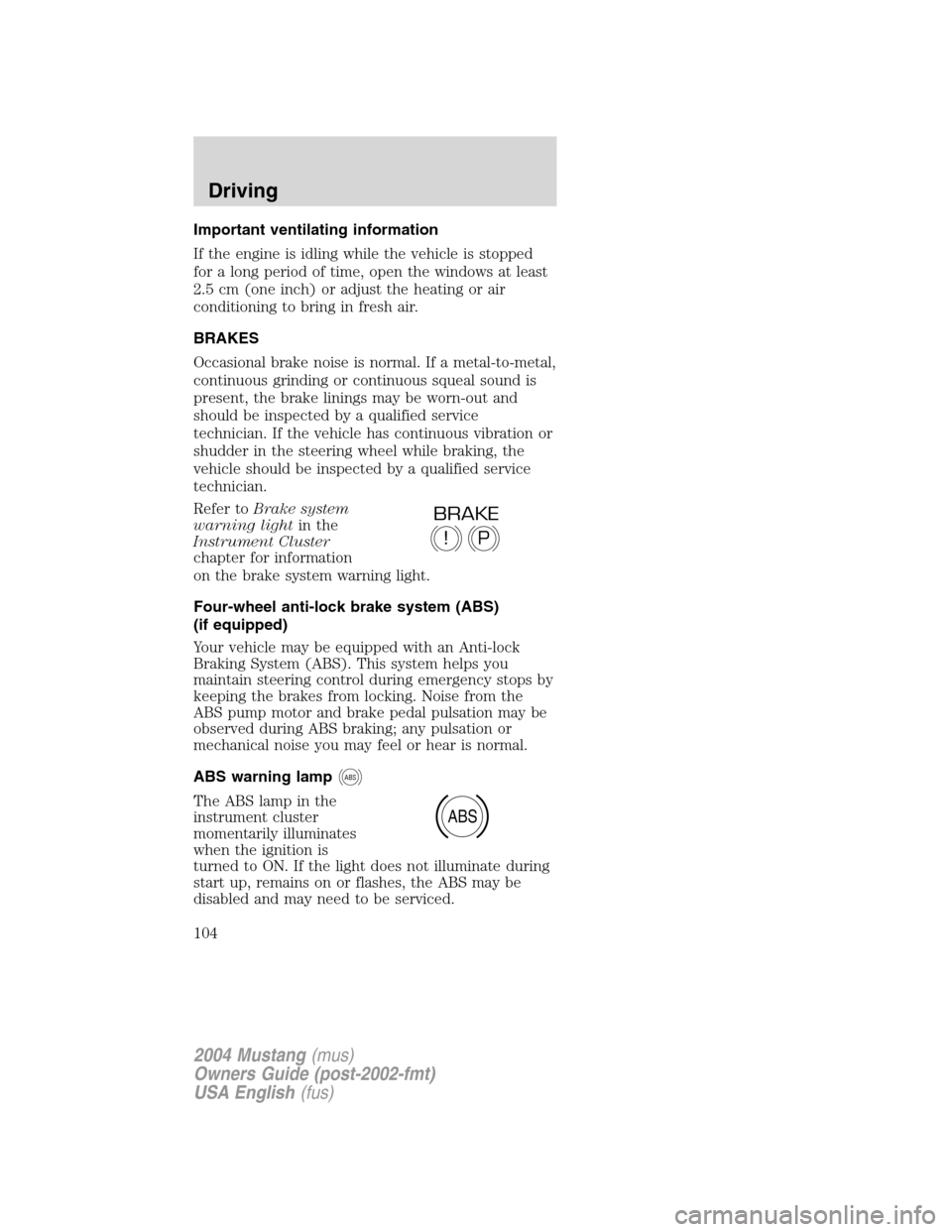
Important ventilating information
If the engine is idling while the vehicle is stopped
for a long period of time, open the windows at least
2.5 cm (one inch) or adjust the heating or air
conditioning to bring in fresh air.
BRAKES
Occasional brake noise is normal. If a metal-to-metal,
continuous grinding or continuous squeal sound is
present, the brake linings may be worn-out and
should be inspected by a qualified service
technician. If the vehicle has continuous vibration or
shudder in the steering wheel while braking, the
vehicle should be inspected by a qualified service
technician.
Refer toBrake system
warning lightin the
Instrument Cluster
chapter for information
on the brake system warning light.
Four-wheel anti-lock brake system (ABS)
(if equipped)
Your vehicle may be equipped with an Anti-lock
Braking System (ABS). This system helps you
maintain steering control during emergency stops by
keeping the brakes from locking. Noise from the
ABS pump motor and brake pedal pulsation may be
observed during ABS braking; any pulsation or
mechanical noise you may feel or hear is normal.
ABS warning lamp
ABS
The ABS lamp in the
instrument cluster
momentarily illuminates
when the ignition is
turned to ON. If the light does not illuminate during
start up, remains on or flashes, the ABS may be
disabled and may need to be serviced.
P!
BRAKE
ABS
2004 Mustang(mus)
Owners Guide (post-2002-fmt)
USA English(fus)
Driving
104
Page 106 of 240

Parking brake
To set the parking
brake (1), pull the
parking brake handle
up as far as possible.
The BRAKE warning
lamp will illuminate and
will remain illuminated
until the parking brake
is released.
To release, press and hold the button (2), pull the
handle up slightly, then push the handle down.
Always set the parking brake fully and make
sure that the gearshift is securely latched in
P (Park) (automatic transmission) or in 1 (First)
(manual transmission).
If the parking brake is fully released, but the
brake warning lamp remains illuminated, the
brakes may not be working properly. See your
dealer or a qualified service technician.
STEERING
To prevent damage to the power steering system:
•Never hold the steering wheel at its furthest
turning points (until it stops) for more than a few
seconds when the engine is running.
•Do not operate the vehicle with a low power
steering pump fluid level (below the MIN mark on
the reservoir).
If the power steering system breaks down (or if the
engine is turned off), you can steer the vehicle
manually, but it takes more effort.
If the steering wanders or pulls, check for:
•an improperly inflated tire
12
P!
BRAKE
2004 Mustang(mus)
Owners Guide (post-2002-fmt)
USA English(fus)
Driving
106
Page 116 of 240
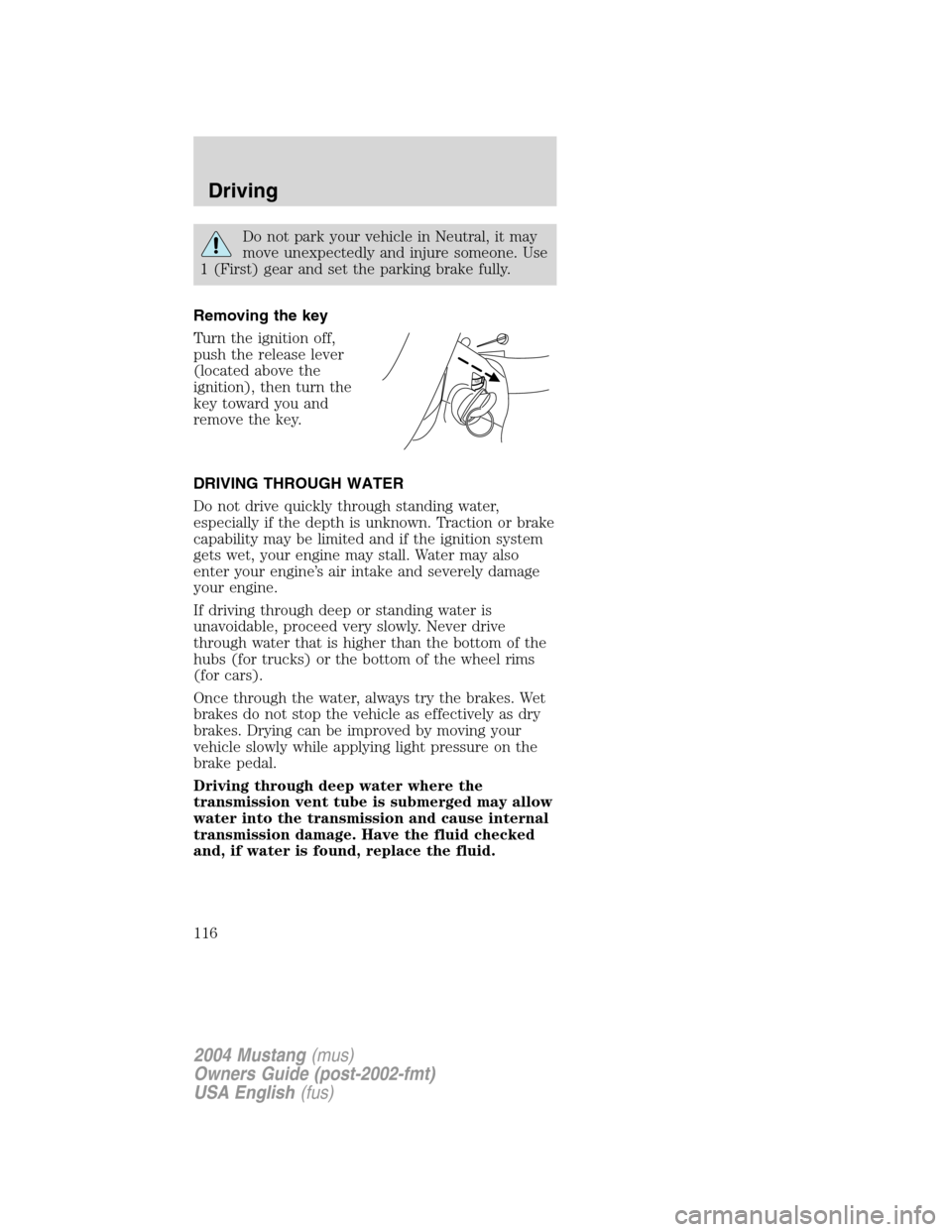
Do not park your vehicle in Neutral, it may
move unexpectedly and injure someone. Use
1 (First) gear and set the parking brake fully.
Removing the key
Turn the ignition off,
push the release lever
(located above the
ignition), then turn the
key toward you and
remove the key.
DRIVING THROUGH WATER
Do not drive quickly through standing water,
especially if the depth is unknown. Traction or brake
capability may be limited and if the ignition system
gets wet, your engine may stall. Water may also
enter your engine’s air intake and severely damage
your engine.
If driving through deep or standing water is
unavoidable, proceed very slowly. Never drive
through water that is higher than the bottom of the
hubs (for trucks) or the bottom of the wheel rims
(for cars).
Once through the water, always try the brakes. Wet
brakes do not stop the vehicle as effectively as dry
brakes. Drying can be improved by moving your
vehicle slowly while applying light pressure on the
brake pedal.
Driving through deep water where the
transmission vent tube is submerged may allow
water into the transmission and cause internal
transmission damage. Have the fluid checked
and, if water is found, replace the fluid.
PUSH
2004 Mustang(mus)
Owners Guide (post-2002-fmt)
USA English(fus)
Driving
116
Page 126 of 240
Passenger compartment fuse panel
The fuse panel is located below and to the left of
the steering wheel by the brake pedal. Remove the
panel cover to access the fuses.
To remove a fuse use the fuse puller tool provided
on the fuse panel cover.
The fuses are coded as follows:
Fuse/Relay
LocationFuse Amp
RatingPassenger Compartment
Fuse Panel Description
1 20A Cigar lighter
2 20A Engine controls
3—Not used
4 10A Right-hand low beam
headlamp
5 15A Instrument cluster, Traction
control switch
6 20A Starter motor relay
7 15A GEM, Interior lamps
8 20A Engine controls
9 30A Mach 460 subwoofers
10 10A Left-hand low beam
headlamp
SEE OWNERS MANUAL FOR FUSE INFO
4212345
76891011
131214151617
191820212223
252426272829
313032333435
373638394041
43
44
2004 Mustang(mus)
Owners Guide (post-2002-fmt)
USA English(fus)
Roadside Emergencies
126
Page 161 of 240
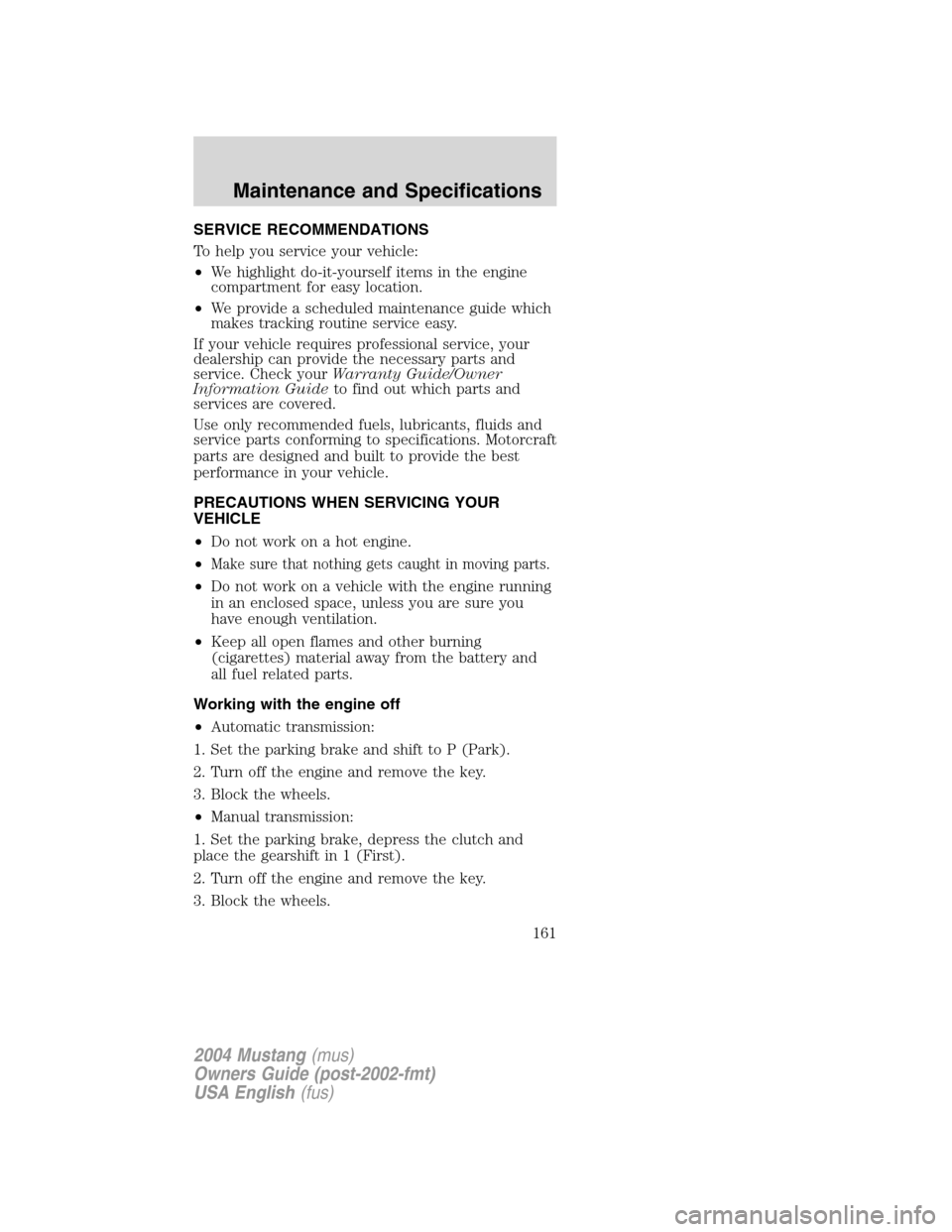
SERVICE RECOMMENDATIONS
To help you service your vehicle:
•We highlight do-it-yourself items in the engine
compartment for easy location.
•We provide a scheduled maintenance guide which
makes tracking routine service easy.
If your vehicle requires professional service, your
dealership can provide the necessary parts and
service. Check yourWarranty Guide/Owner
Information Guideto find out which parts and
services are covered.
Use only recommended fuels, lubricants, fluids and
service parts conforming to specifications. Motorcraft
parts are designed and built to provide the best
performance in your vehicle.
PRECAUTIONS WHEN SERVICING YOUR
VEHICLE
•Do not work on a hot engine.
•
Make sure that nothing gets caught in moving parts.
•Do not work on a vehicle with the engine running
in an enclosed space, unless you are sure you
have enough ventilation.
•Keep all open flames and other burning
(cigarettes) material away from the battery and
all fuel related parts.
Working with the engine off
•Automatic transmission:
1. Set the parking brake and shift to P (Park).
2. Turn off the engine and remove the key.
3. Block the wheels.
•Manual transmission:
1. Set the parking brake, depress the clutch and
place the gearshift in 1 (First).
2. Turn off the engine and remove the key.
3. Block the wheels.
2004 Mustang(mus)
Owners Guide (post-2002-fmt)
USA English(fus)
Maintenance and Specifications
161
Page 228 of 240
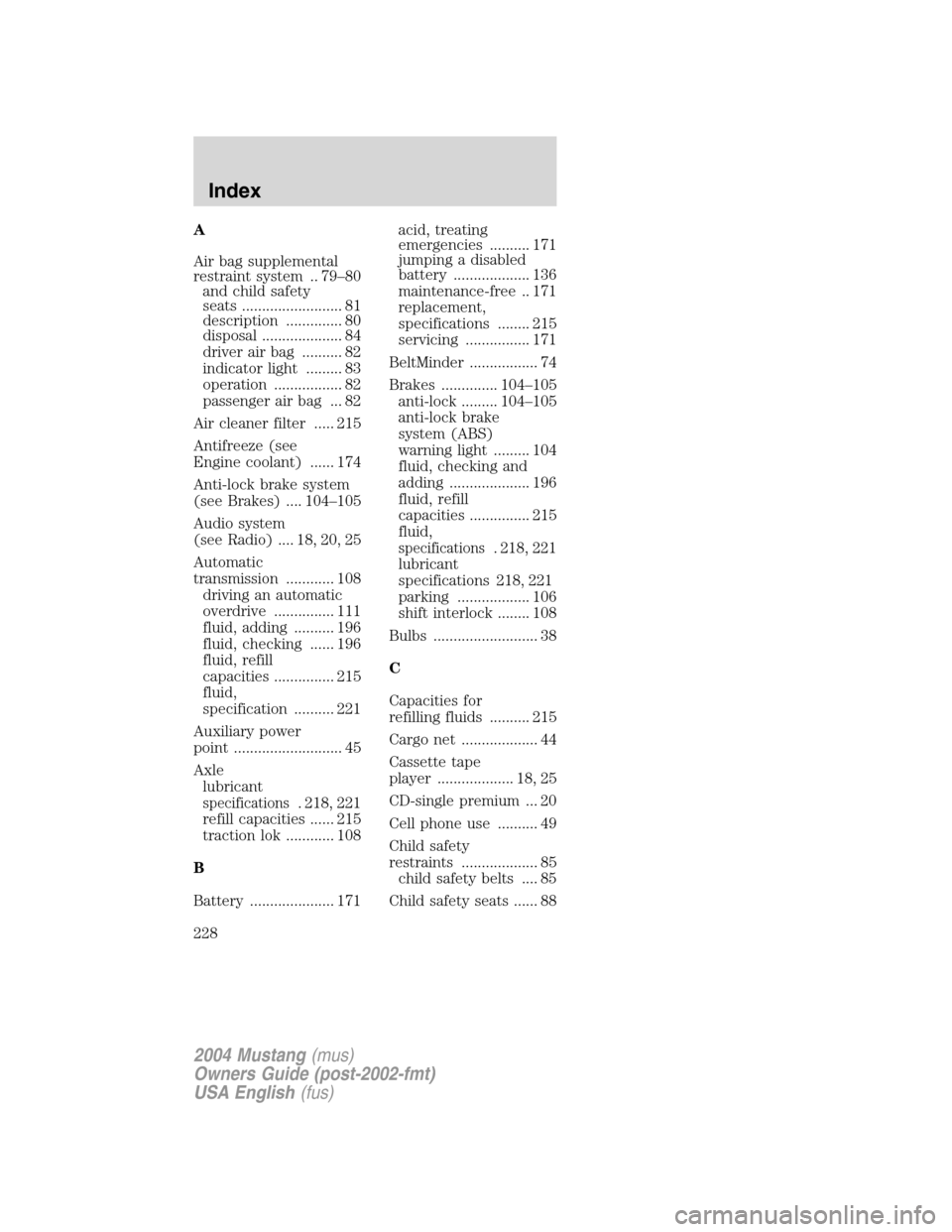
A
Air bag supplemental
restraint system .. 79–80
and child safety
seats ......................... 81
description .............. 80
disposal .................... 84
driver air bag .......... 82
indicator light ......... 83
operation ................. 82
passenger air bag ... 82
Air cleaner filter ..... 215
Antifreeze (see
Engine coolant) ...... 174
Anti-lock brake system
(see Brakes) .... 104–105
Audio system
(see Radio) .... 18, 20, 25
Automatic
transmission ............ 108
driving an automatic
overdrive ............... 111
fluid, adding .......... 196
fluid, checking ...... 196
fluid, refill
capacities ............... 215
fluid,
specification .......... 221
Auxiliary power
point ........................... 45
Axle
lubricant
specifications. 218, 221
refill capacities ...... 215
traction lok ............ 108
B
Battery ..................... 171acid, treating
emergencies .......... 171
jumping a disabled
battery ................... 136
maintenance-free .. 171
replacement,
specifications ........ 215
servicing ................ 171
BeltMinder ................. 74
Brakes .............. 104–105
anti-lock ......... 104–105
anti-lock brake
system (ABS)
warning light ......... 104
fluid, checking and
adding .................... 196
fluid, refill
capacities ............... 215
fluid,
specifications. 218, 221
lubricant
specifications 218, 221
parking .................. 106
shift interlock ........ 108
Bulbs .......................... 38
C
Capacities for
refilling fluids .......... 215
Cargo net ................... 44
Cassette tape
player ................... 18, 25
CD-single premium ... 20
Cell phone use .......... 49
Child safety
restraints ................... 85
child safety belts .... 85
Child safety seats ...... 88
2004 Mustang(mus)
Owners Guide (post-2002-fmt)
USA English(fus)
Index
228